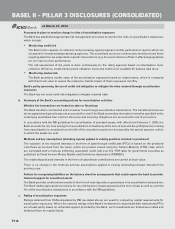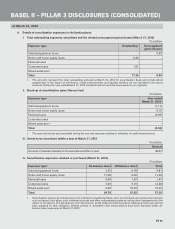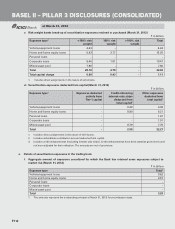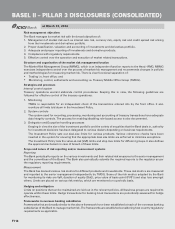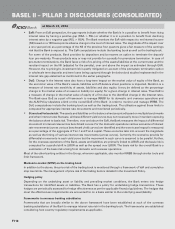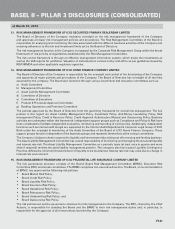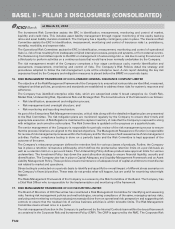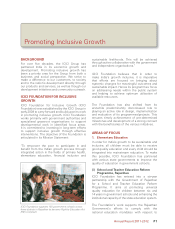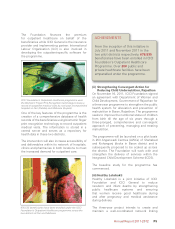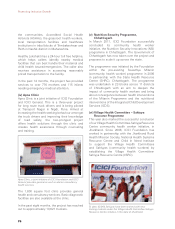ICICI Bank 2012 Annual Report Download - page 198
Download and view the complete annual report
Please find page 198 of the 2012 ICICI Bank annual report below. You can navigate through the pages in the report by either clicking on the pages listed below, or by using the keyword search tool below to find specific information within the annual report.
F120
Risk measurement and reporting framework
The Bank proactively manages liquidity risk as a part of its ALM activities. The Bank uses various tools for measurement
of liquidity risk including the statement of structural liquidity (SSL), dynamic liquidity gap statements, liquidity ratios and
stress testing through scenario analysis.
The SSL is used as a standard tool for measuring and managing net funding requirements and assessment of surplus
or shortfall of funds in various maturity buckets in the future. The cash flows pertaining to various assets, liabilities
and off-balance sheet items are placed in different time buckets based on their contractual or behavioural maturity. For
non-maturity assets/liabilities e.g. working capital facilities on the assets side and current account & savings account
deposits on the liabilities side grouping into time buckets is done based on the assumptions. The SSL for INR operations
is prepared on daily basis for the domestic operations of the Bank and SSL for international operations of the Bank is
prepared periodically and the utilisation against gap limits laid down for each bucket are reviewed by ALCO.
The Bank also prepares dynamic liquidity gap statements, which in addition to scheduled cash flows, also considers the
liquidity requirements pertaining to incremental business and the funding thereof. The dynamic liquidity gap statements
are prepared in close coordination with the business groups, and cash flow projections based on the same are presented
to ALCO periodically. As a part of the stock and flow approach, the Bank also monitors various liquidity ratios, and limits
are laid down for these ratios under the ALM Policy.
Further, the Bank has a Board approved liquidity stress testing framework, as per which the Bank gauges its liquidity
position under a range of stress scenarios. These scenarios cover Bank specific and market-wide stress situations and
have been designed for the domestic and the international operations of the Bank. The potential impact on the Bank’s
financial position for meeting the stress outflows under these scenarios is measured and is subject to a stress tolerance
limit specified by the Board. The results of liquidity stress testing are reported to ALCO on a monthly basis.
The Bank has also framed a Liquidity Contingency Plan (LCP), which serves as a framework for early identification and
calibrated action in the event of tight liquidity conditions. The LCP includes various indicators, which are monitored
regularly, and lays down the mechanism for escalation, remedial action and crisis management until return to normalcy.
Liquidity management
The Bank has diverse sources of liquidity to allow for flexibility in meeting funding requirements. For the domestic
operations, current accounts and savings deposits payable on demand form a significant part of the Bank’s funding
and the Bank is working with a concerted strategy to sustain and grow this segment of deposits along with retail
term deposits. These deposits are augmented by wholesale deposits, borrowings and through issuance of bonds and
subordinated debt from time to time. Loan maturities and sale of investments also provide liquidity. The Bank holds
unencumbered, high quality liquid assets to protect against stress conditions.
For domestic operations, the Bank also has the option of managing liquidity by borrowing in the inter-bank market on
a short-term basis. The overnight market, which is a significant part of the inter-bank market, is susceptible to volatile
interest rates. To limit the reliance on such volatile funding, the ALM Policy has stipulated limits for borrowing and
lending in the inter-bank market. The Bank also has access to refinancing facilities extended by the RBI.
For the overseas operations too, the Bank has a well-defined borrowing program. The US dollar is the base currency
for the overseas branches of the Bank, apart from the branches where the currency is not freely convertible. In order
to maximise the borrowings at reasonable cost, liquidity in different markets and currencies is targeted. The wholesale
borrowings are in the form of bond issuances, syndicated loans from banks, money market borrowings, inter-bank
bilateral loans and deposits, including structured deposits. The Bank also raises refinance from banks against the buyer’s
credit and other forms of trade assets. The loans that meet the criteria of the Export Credit Agencies are refinanced as
per the agreements entered with these agencies. Apart from the above the Bank is also focused on increasing the share
of retail deposit liabilities at overseas branches, in accordance with the regulatory framework at the host countries.
Frameworks that are broadly similar to the above framework have been established at each of the overseas banking
subsidiaries of the Bank to manage liquidity risk. The frameworks are established considering host country regulatory
requirements as applicable. Besides, as per local regulatory requirements, ICICI Bank UK PLC has implemented its
Individual Liquidity Adequacy Assessment (ILAA) framework, which stipulates the level of liquidity required to meet the
UK regulatory requirements and the liquidity commensurate with the risks identified in its portfolio and strategic plans.
In summary, the Bank has in place robust governance structure, policy framework and review mechanism to ensure
availability of adequate liquidity even under stressed market conditions.
BASEL II – PILLAR 3 DISCLOSURES (CONSOLIDATED)
at March 31, 2012


